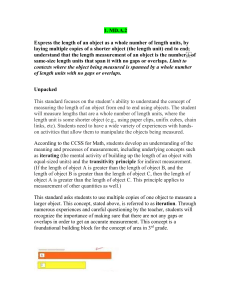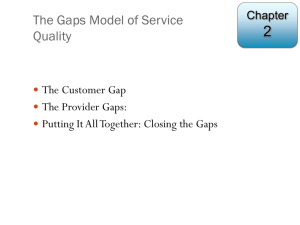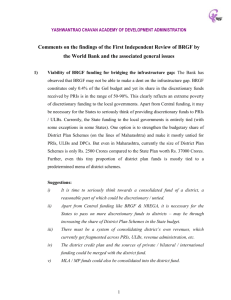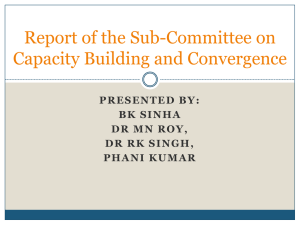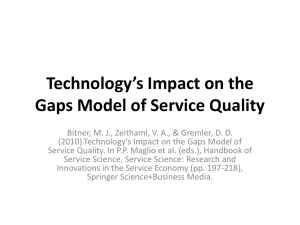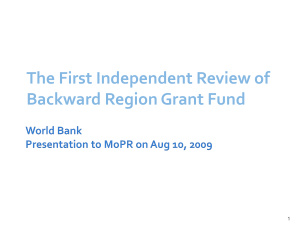Chapter-2 - NIRD and
advertisement
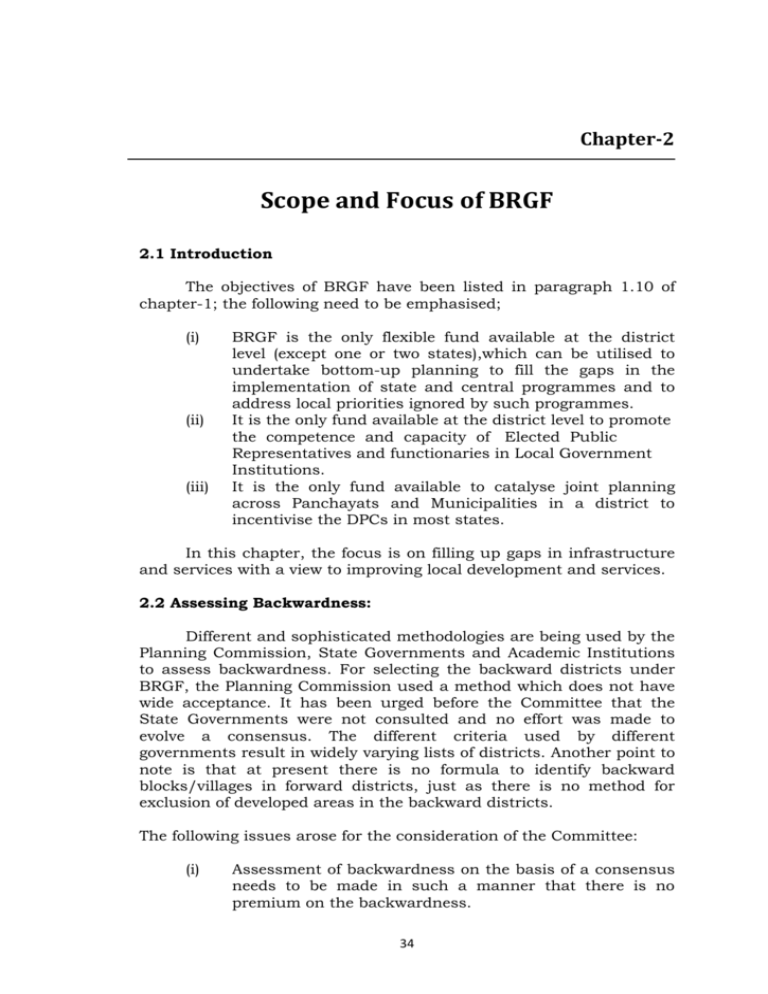
Chapter-2 Scope and Focus of BRGF 2.1 Introduction The objectives of BRGF have been listed in paragraph 1.10 of chapter-1; the following need to be emphasised; (i) (ii) (iii) BRGF is the only flexible fund available at the district level (except one or two states),which can be utilised to undertake bottom-up planning to fill the gaps in the implementation of state and central programmes and to address local priorities ignored by such programmes. It is the only fund available at the district level to promote the competence and capacity of Elected Public Representatives and functionaries in Local Government Institutions. It is the only fund available to catalyse joint planning across Panchayats and Municipalities in a district to incentivise the DPCs in most states. In this chapter, the focus is on filling up gaps in infrastructure and services with a view to improving local development and services. 2.2 Assessing Backwardness: Different and sophisticated methodologies are being used by the Planning Commission, State Governments and Academic Institutions to assess backwardness. For selecting the backward districts under BRGF, the Planning Commission used a method which does not have wide acceptance. It has been urged before the Committee that the State Governments were not consulted and no effort was made to evolve a consensus. The different criteria used by different governments result in widely varying lists of districts. Another point to note is that at present there is no formula to identify backward blocks/villages in forward districts, just as there is no method for exclusion of developed areas in the backward districts. The following issues arose for the consideration of the Committee: (i) Assessment of backwardness on the basis of a consensus needs to be made in such a manner that there is no premium on the backwardness. 34 (ii) (iii) The need to decide on the level at which backwardness is to be assessed (District/Block/Village). The state of West Bengal has gone down to the village level, just using two criteria, namely female literacy and employment Need to evolve consensus on the data to be used-One view is that the 2001 Census data may be used. The other view is that the 2001 Census data is already outdated and since the new Census data will be available only in 2013 or 14, surveys using smaller parameters may be done immediately. The fact is that such surveys will also take time and that the practicable course could be to take 2001 Census data along with surveys by the states (some States have already done such surveys). 2.3 Filling Critical Gaps One of the objectives of Backward Regions Grant Fund is to fill critical gaps, which emerge in the process of sectoral, top down and departmental implementation of developmental programmes. Critical gaps are defined as the last mile provision or initiative to fill the missing element that will make an asset productive or a facility functional. There are several such critical gaps or missing elements in rural areas. They arise on account of several reasons: (i) (ii) (iii) (iv) Creation of ‘physical infrastructure’ and not ensuring the needed ‘soft infrastructure’ for the created infrastructural to be functional or fully effective. Digging wells but no energisation, health centres without staff or adequate medicines etc are examples of such gaps. Promotion of enterprises without simultaneously working on forward linkages. Providing milch animals to beneficiaries under various programmes without provisioning milk collection centres, etc are the examples such gaps. Provision of the inadequate or partial infrastructure/services. Rural roads without culverts or bridges to make the road functional during monsoon season, provision of TV to schools without power connection, toilets without water supply, schools without buildings, teachers, blackboards, doctors without hospitals and the vice versa , etc are the examples of such gaps. Lack of functional capacities to deliver the assigned roles. Lack of skilled/technical staff or capacity building provisions in the technical departments and other institutions such as DPCs are the examples of such gaps. Providing ‘access’ without ensuring provision for ‘services’ by the access. Taps without drinking water, PDS without 35 (v) ration cards, power connection without power supply may be examples of such gaps. All most all the above gaps and deficiencies arise out of the failure to ensure ownership of the infrastructural facilities and programmes by Local Government Institutions. They are looked upon as stand alone assets owned /operated by the parastatals or departments of Union or the States. There are several other instances where with minimal investment, the missing elements could be provided and the critical gaps bridged. Convergence is the only solution to effectively deal with such critical gaps, even without much additional or new financial resource. 2.4 Meeting Local Infrastructure Deficit There are several programmes of the Centre and States, as well as donor funded programmes/projects to meet the local infrastructural needs. Usually, such programmes/ projects are sector specific or area specific. Some of the major programmes of development do have some earmarked funds to fill the critical gaps like earmarking infrastructure funds under SGSY. While some of these programme funds are ‘tied’ in nature, a few programmes provide a partially ‘untied’ fund (because of broad spectrum of permissible and impermissible items) and some have an earmarked portion of the project funds. Invariably, these programmes are planned and infrastructure needs are finalized at the district level and sanctioned at state level with minimal role at local level. The following are some of the major programmes that provide infrastructure: (i) Education: Sarva Siksha Abhyan (SSA), Finance Commission Grant (ii) Health: National Rural Health Mission, ICDS (iii) Road Connectivity: PMGSY, MGNREGS, RIDF of NABARD, Finance Commission Grant (iv) Sanitation: TSC, Externally funded projects (v) Micro Enterprises: SME, SGSY, RKVY, National Horticulture Mission (NHM), RIDF of NABARD, Ministry of Food Processing (vi) Electricity: Rajiv Gandhi Grameen Vidyutikaran Yojana, Remote Village Electrification, Non-conventional Energy Programme (vii) Natural Resources: NREGS, RKVY, MoE&F, IWDP, Externally funded projects (viii) Market Infrastructure: RKVY, SGSY, Agriculture Marketing Boards, Fisheries Department, Commodity Boards etc. For want of adequate resources, many a 36 times, political influence and patronage system robs away the resources from more needy areas/ sections of community. The degree of participation by local governments varies widely in these programmes. One of the critical issues in the development of infrastructure at GP and Block level is the withdrawal of SGRY with the advent of MGNREGA. SGRY provided a minimum of 50% of its allocation to the GPs, 30% to Blocks Panchayat and 20% to District Panchayats. This amount was used to create economic and social infrastructure at the local level. A wide variety of infrastructure was permitted under SGRY. With the introduction of MGNREGA, such flexibility has been curtailed and most of the infrastructure that used to be built under SGRY is not permissible under MGNREGS. Though the average fund available at a GP level under SGRY might be around Rs 50,000– Rs.80,000 per year, some infrastructure work was taken up. Additional works were done by Block and District Panchayats. This deficit can be addressed by BRGF in the backward districts. 2.5 Indicative list of gaps for funding under BRGF Programme In the programme guidelines issued by MoPR, there is a list of priority schemes fund earmarked for SCs/STs development (annexure-4 to BRGF guidelines). It is suggested that in addition to that list the following indicative list of gaps in different sectors may be included in the guidelines both for marginalized groups and others: Table-2.5.1 Indicative list of gaps for funding under BRGF Programme Sector Education Health Suggested Critical Gap Construction of Compound walls Construction of Toilet Complexes (boys and girls) Provision of furniture Construction of kitchen sheds Completion of incomplete school buildings Development of play grounds in schools Construction of Health Sub Centre Buildings Provision of electricity facility to Health SubCentres Provision of toilet and drinking water facilities to PHCs/Health Sub-Centres Completion of incomplete PHCs/Health Sub 37 Animal Husbandry Social Welfare/BC Welfare Agriculture Women and Child Welfare Rural Supply Water Electricity Panchayat Raj Gram Panchayat level Fertiliser Bank1/PDS Centres Buildings Construction of buildings for Rural Live Stock Units Provision of Cattle Trevis Augmenting the infrastructure in Veterinary Dispensaries Completion of incomplete RLUs/Dispensaries Construction of Hostel Building with special focus on Girls Hostels Furniture in Social Welfare/Backward Classes Welfare Hostels Completion of incomplete Hostel Buildings Cold storage Units Market Yards Storage-godowns Construction of Anganwadi Centres Provision of Drinking water facilities in Anganwadi Centres Provision of Toilet facilities Electrification of existing Anganwadi Centres Provision of play material to Anganwadi Centres Extension of Pipe-lines Electric motors to Pump sets Energisation charges Flushing of Bore wells Sinking of Bore wells Provision of Electric poles Electrification of un electrified SC/ST villages and new colonies Construction of Gram Panchayat Offices Augmentation of infrastructure in PRIs Intermediate Panchayat Resource Centres Improvements to burial grounds Internal roads and drains Construction of godowns/stock centres Making arrangements for transport. Empowerment of Gram Panchayats for managing PDS B.K. Sinha, Joint Secretary, Ministry of Panchayat Raj, Government of India, Study on Supply-Distribution of Urea in India, 1 38 2.6 Infrastructure and Inclusive Growth It is well established that creation of infrastructure, both economic and social, is the key to ‘inclusive growth’. Improvement in infrastructure gives a fillip to many economic activities, as it has significant multiplier effect. Clear examples are: rural connectivity (Road, Telephone, and Transport), power (energisation of wells and micro enterprises), chilling centres (for milk collection, vaccine/ artificial insemination, semen storage etc.). The examples of mobile phone and internet connectivity for onion, poultry and milk producers in Maharashtra, Karnataka and Tamil Nadu have proved that these have resulted substantial benefits to the target groups. The recent introduction of ‘108’ service in some States has a mass appeal and is widely acclaimed there. (i) (ii) India Rural Development Report (1999) brought out by NIRD clearly established the linkages between development in economic and social infrastructure and poverty and as well as disparities in development. Poorer states (high poverty incidence states) are also poor in infrastructure development. India Infrastructure Report 2006 points out that rural teledensity has improved significantly between 1999 and 2004, but has remained stagnant due to slow pace of other development. (iii) Indian Rural Infrastructure Report (2007) brought out by NCAER brings out several case studies and findings to illustrate how investment in infrastructure can make a change in the lives of common people. (iv) The ‘Grameen Phone’ in Bangladesh has a tremendous impact on poverty. Similar experiments by SEWA in Banaskantha district of Gujarat has proved highly beneficial. ‘Wired villages’ in Warana Region of south western Maharashtra, non-government initiatives of internet services in MP, Maharashtra, TN etc. have made substantial difference to the lives of rural people. (v) The World Development Report 1994, on Infrastructure Development and the Report of 2000 focusing on Attacking Poverty have shown that a regular, good quality power supply boosted agricultural productivity, setting up of post harvest processing units and improving the educational achievements of school students. (vi) According to the 11th Plan Document about 35 % of all habitations are still unconnected by all-weather roads. Even the reportedly connected village roads are unserviceable. 39 Again, the backward States have the poorest road density and substantial unconnected villages clearly showing the nexus between road connectivity and development. (vii) Providing ‘access’ is not an end itself but whether access has led to ‘service’ delivery of quality is the question. Teacher less schools, staff less health centres, extension with rural workers, unenergised infrastructure etc. have resulted in poor utilization affecting the quality. The critical gaps in human resources can be filled through cheaper front line staff like paravets, barefoot technicians, vidya volunteers etc. Such initiatives in Karnataka, MP and AP have shown good results. (viii) Improvement in land productivity is very essential when the arable land is shrinking due to industrialization, and urbanization. Infrastructure technology, water and energy are critical inputs, as averred by India Infrastructure Report 2009, to improve productivity and to meet the food security objective. 2.7 Priorities in Agricultural Sector The major requirements of development in agriculture are efficient utilisation of land and water resources. Common property resources on which the poor depend for their livelihoods have to be made more productive. While preparing schemes under BRGF it is necessary to clearly identify directly productive investment or investment which is ineffective because of incomplete investment. Mere creation of infrastructure may not ensure genuine access until there is provision to give the intended service. To this end, District Plans should clearly spell out the means for both hard and soft-ware to provide justification for the identified infrastructure. The following are some of the priority areas for consideration under BRGF: (i) Development of fisheries on water bodies. (ii) Making grazing lands more productive. (iii) Improving the accessibility of drinking water to the poor. (iv) Providing market infrastructure. (v) Wherever milk production is available but collection centre is not available, centres may be started. 2.8 Development Requirements at Local Level Construction of buildings and undertaking the repairs of the service delivery institutions like health, education, drinking water, housing, road, Panchayat building, computers. Play ground, 40 compound walls of schools, Anganwadi Centre and toilets, individual and common sanitary latrines, drainage canals, kitchen-sheds for MDM, DWCRA buildings, youth-clubs, old-age homes etc. All these requirements should emerge from the community vision and participatory planning processes. Development requirements are being met from the Centrally Sponsored Schemes, Central and State Finance Commissions Grant, State Government Programmes, Internal Resources of PRIs and Community Contribution. 2.9 Brief Analysis of Sector-wise investment Table 2.9.1 presents the distribution of expenditure under BRGF on different activities in some of the Districts across eight States in the country. It may be seen from the table that in the state of Andhra Pradesh 25% of the total funds were used for Anganwadis and more than 27% on other activities. Very little investment has been made in providing health and roads facilities; however, investment in drinking water, irrigation and school class room constitute more than 25% of expenditure. In case of Bongaigaon of Assam more than 90% of the funds were utilised for construction of roads, drainage, culvert and activities related to agriculture/livelihoods and market. In case of Moriegaon District of the same State, 100% of funds were invested in activities related to agriculture and fisheries. In Samasthipur district of Bihar more emphasis was given for Gram Panchayat buildings and administration. In case of Chhattisgarh, highest investment was made on infrastructure and housing followed by health and nutrition. In Madhya Pradesh 44 per cent of the total funds were invested on Angawadi buildings, followed by construction of schools/class rooms and drinking water/irrigation. In the state of Orissa, no sector overview is available but most of the projects are within Anganwadi Centres, roads, culverts, classrooms, water supply and rural electrification. In case of Rajasthan, 47% of funds were invested in construction of Anganwadi centres, followed by activities under others and roads. In Bankura district of West Bengal, 30% of funds were utilised for other activities followed by Anganwadi and roads/drain/culverts. This has to be compiled over a period of time for all districts. It could be seen from the sample study that the bulk of the funds had been spent on construction activities relating to public service facilities such as Anganwadi buildings, education, and road/drainage/culvert. This will be attempted as part of state specific studies in the future. There is need for more detailed study of the pattern and sector-wise expenditure investments made across BRGF Districts and to analyse the process of decision making on considering the gaps in critical social and economic infrastructure. The Committee would take it up as part of State specific study in future. 41 Table-2.9.1 Sector-wise Investment States Angawandi Buildings and women and child development 25.0 % 0% GP Buildings and Administration Hostels Drinking Water/ Irrigation Health Electrification Schools/ Class-rooms 9.6% 7% 1.9% 0% 13.6% 2% 2.0% 0% 4.4% 0% 16.3% 0% 0% 45% Assam Morigaon District (2006/07) Bihar Samastipur District (FY 2008/09) Chhattisgarh 0% 0% 0% 0% 0% 0% 0% 0% 23 % most AW 40%(Infrastruct ure and buildings 41 % (Infrastructure and houses) 4% 23% 27.1% 46% (agric + lively-hoods, market) 100% for agric + fishery 7% 4% 3% 8% Madhya Pradesh Orissa 44% 0% 0% 13% 5% 2% 14% 9% 13% No sector overview is available but most projects are within Anganwadi Centers, Roads, Culverts, classrooms, water supply and rural electrification. 47% 4% 0% 0% 9% 0% 4% 17% 19% 28% 10% 0% 7% 1% 0% 2% 22% 30% Andhra Pradesh Assam Bongaigaon District (2006/07) 0% 5% 0% 0% 36% Health and 8% Roads/ culverts Others nutrition Rajasthan West Bengal (Source: First Independent Review of the Backward Regions Grant Fund Synthesis Report, World Bank, 2010, p 16.) 42 2.10 Utilization of funds under BRGF and Issues in filling up critical gaps Out of total districts covered under BRGF, as many as 211 districts did not use even 50% of BRGF funds. However, there is a lot of scope for the gap filling interventions in these districts. Some of the major issues in this regard are listed below. (i) (ii) (iii) (iv) (v) There is no proper mechanism for participatory identification of the critical gaps. The critical gaps arise because these gaps exist in the planning process. There are about 100 CSSs and a number of Special Assistance Programmes and State Sector Schemes. The budget of these schemes and programmes has been increasing every year as could be seen in the Table-5.5.1 (page.83) in chapter 5 of this report. The World Bank study revealed that wherever there has been integrated or convergent planning process operating at the grassroots, the gaps in the infrastructure get reduced and there are returns to the community greater than the sum of the parts. The improvements in the planning process are discussed in chapter-4. The gaps in the planning process occur because of the fundamental problem of communication between the planners and the stakeholders. It has been corroborated by a number of field studies that the planning process has become contractor-driven. The TSIs have become contractors and they further outsource the planning job to the local agencies. There is little cooperation from the DRDA or from the Panchayats except that the plans should be completed in time and should receive the approval of the DPC and the HPC. The approval of the DPC is taken for granted. This reduces participatory planning to farcical proportions. The Committee is of the opinion that these two parts never get to talk to each other. The day this gap is bridged through the methodologies of planning designed for the BRGF, the allocations would be used fully. It is not a case of coming out with a fresh planning design but one of the operationalisation of planning processes already in place. 43 2.11 Lapsability of Funds It has to be understood that removal of backwardness is not a one-shot affair that can be achieved within the parameters of short term budget centric goals of the programmes of the Ministries. Backwardness is a complex phenomenon whose roots may run into social conditions, historical background, inefficient appreciation and use of resources etc. No doubt, creation of infrastructural linkages will have the effect of filling up critical gaps and, hence, of better resource utilization. Yet, there are dimensions that need to be added to capacity building of the constituents, the gestation period of the capacity building, the factors of backwardness like the human capital, the status of health, the time span within which the programme is being considered etc. The Committee feels that to take a short time span of one financial year for the programme is not a viable proposition. This is because of the fact that there may be tendencies on part of the programme to lapse into backwardness on account of other factors that had hitherto remained dormant and become active again. Hence, there is a need to look at the BRGF in a longer time span of a minimum of 5 years. This would legitimately beg the question as to why it is 5 years or not more or less. The answer is that it is within a span of 5 years that a cycle of development normally gets fulfilled. The Planning Commission is also guided by this cycle in its planning process. The Committee also feels that a good part of the time of the programme divisions and executive agencies is consumed in getting releases of funds. The entire orientation of the programme is directed towards the goal to obtain the funding support. Utilization of the funds for the purpose of the programme design does not figure high in their objectives. The Central Government authorities realize this fundamental weakness of the situation and try to make the requirements as stringent as possible. Hence, BRGF gets overly focused on getting releases and does not focus on other aspects including the primary objective of removal of backwardness. If BRGF is to do well as a programme in fulfillment of the objectives it must be freed from the thralldom of a rigid release structure. It is only then that the managers of the programme can concentrate on the delivery of the programme. The time freed from simplification and taking a long term view of the programme could be used for better planning, implementation and supervision. 44 2.12 Creating a Charge upon the Fund The very nature of BRGF fund is that of an untied one. It is its strongest point yet. Some of the Members of the Committee and some persons deposing before it were of the view that broad purposes for which fund could be used may be indicated. A broader indicative list of gaps has been suggested in Para 2.5 and brief analysis of a sector wise investment was made in 2.9. The Committee does not wish to go further and broaden the list. At the same time, the Committee also takes cognizance of the wide range of programmes that are implemented under different programme structures. For instance, the Ministry of Rural Development has come up with a nation wide programme of Bharat Nirman Rajiv Gandhi Sewa Kendra (BNRGSK) under which Gram Panchayat buildings will be constructed with facilities for location of a knowledge centre, training and meeting hall, exhibition of agricultural implements and technologies etc. All the 2.34 lakh Gram Panchayats will be equipped with such Sewa Kendras. The fact that in some of the States, priority is being given to the construction of buildings for GPs because of the fact that there is no convergence in the planning process. Once that convergence is brought about, the gaps are likely to reduce appreciably. The Committee also takes note of the efforts being made by other Ministries/Departments of the Government of India to bring about convergence in Government programmes. In particular, it would like to mention the Convergence Guidelines issued by the Ministry of Rural Development, which provides for convergence at a large scale amongst different Departments. Even if convergence were to be achieved on a lower scale, it would bring about major changes on ground. The Committee would also like to point out that despite the best efforts at unified planning, some gaps will continue to exist. However, the nature of the gaps will be transient and relatively insignificant. 2.13 BRGF and Livelihoods Though, BRGF has been primarily conceived as a programme for filling up the gaps in the rural infrastructure it can be used for their locally important purposes. In some States, it has been used for livelihood projects. There are number of programmes under CSSs portfolio related to livelihood. The SGSY is primarily a livelihood programme, which deals with both skill development and self employment. MGNREGA provides 100 days wage employment. The Committee is of considered opinion that the programme demands greater emphasis on the gaps in 45 the livelihoods. The Committee also takes note of the growth of more than one million SHGs in the State of Andhra Pradesh under the Indira Kranti Patham (IKP). The SHGs have been able to gain in measures of financial strength and capacity. They have also been able to organize themselves in the form of Village Organizations (VOs), Block Panchayat Level Samakhyas, District Samakhyas and State Level Federations. Seven other States have also initiated a World Bank sponsored programme for replication of IKP model. Each SHG and their formations are units of planning. Their livelihood enhancement action plans are nowhere being captured in the district planning process. This leads to a duplication of efforts and often planning at cross purposes. It is felt that unless planning of SHGs and their constituent units are brought within the ambit of one broad umbrella of planning, BRGF will remain incomplete and partial. This is dealt with in greater detail in the Chapter-4. 2.14 Recommendations: Based on above discussion on the issue of filling the gaps under BRGF, following measures are recommended to make the programme more effective and meaningful. 1. 2. 3. 4. The BRGF should continue with its untied nature and emphasis on filling up developmental gaps. It should also continue to focus on its emphasis on capability building, constitution of DPCs and catalyze planning across rural and urban areas in the district. Every District should come out with the district profile of backwardness to be upgraded once in every three years. Although sophisticated and well-thought methodologies have been applied to measure the backwardness in the last few decades, however, there is no consensus on the parameters. It is therefore, suggested that a simple, verifiable and measurable index of rural backwardness be evolved by the MoRD, MoPR and Planning Commission in consultation with the States. The unit for determination of backwardness may be the Block. At present monitoring of BRGF is mostly on releases and expenditure. Since BRGF is an intensively process oriented programme, a system for multi-level quality, process, financial and out come is needed. Such a system has already been successfully established for significant number of programmes such as MGNREGA, PMGSY, Drinking Water and Sanitation, Integrated Watershed Development Programme etc. This monitoring mechanism should be established by technically competent organisations such as C-DAC, ANTRIX Corporation (ISRO), ECIL, NIC, TCS, etc. NIRD would 46 5. 6. 7. 8. 9. 10. 11. propose draft criteria and methodology for purposeful monitoring. Based upon which MoPR would establish monitoring unit for IT based monitoring. Since the purpose of the BRGF is to fill the gaps in developmental infrastructure, it is necessary to identify the level of development of different Blocks and give priority to the bottom one-third of the Blocks for investment under the Grant, to fill all the existing gaps within a given time-period. Similarly, identification of backward Gram Panchayats can also be undertaken wherever feasible as already done in West Bengal and Maharastra. A National Portal on Basic Indicators of Development should be created by the Ministry of Panchayati Raj. The e-Panchayats programme of MoPR, Computerization Programme of MoRD having allocation Rs. 1300 crore and Panchayat Ghar component of Bharat Nirman Rajeev Gandhi Sewa Kendra should be dovetailed for computerization of the Local Bodies. The allocation should be viewed over a period of 5 years and not for a year alone. For completion of schemes/projects under BRGF must have a long term perspective. The projects taken up should be given sufficient time for their completion whenever this involves more than one year time. The committee strongly urges the extension of BRGF in 12th Plan period keeping in view the long term perspective for the programme. This will ensure completion of schemes/projects. The process of release needs to be simplified. The Districts will plan and indicate a sector and scheme wise requirement of funds, before the beginning of the financial year. This will become the basis for the release of funds. There should be some incentive for expenditure incurred within or before time. Likewise there ought to be a disincentive for late, tardy or poor utilization of funds. The disincentive could come in a number of ways such as losing a part of the funds; requiring the State to do an additional exercise before further release etc. However, it may be mentioned that the quality of the expenditure and the outcome of the investment will need to be carefully assessed before arriving at the incentive or disincentive. There is need for close convergence between BRGF and other Livelihood Programmes of the Government. Sectoral Planning for livelihoods should be under one umbrella planning process. There should be one Integrated Livelihood Plan for the whole District. 47
